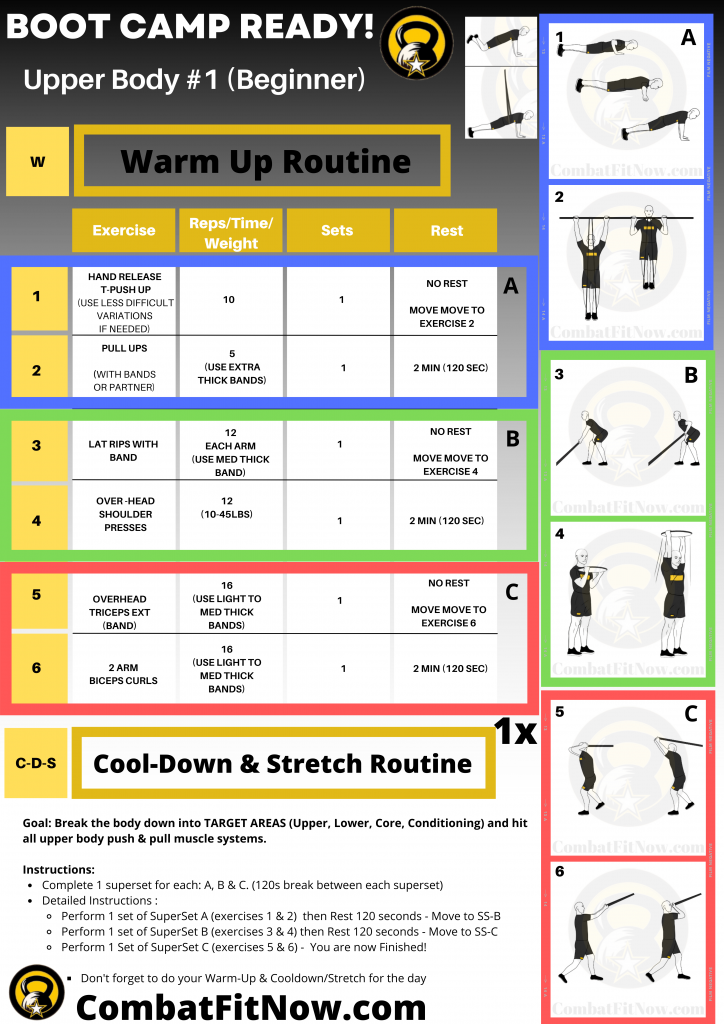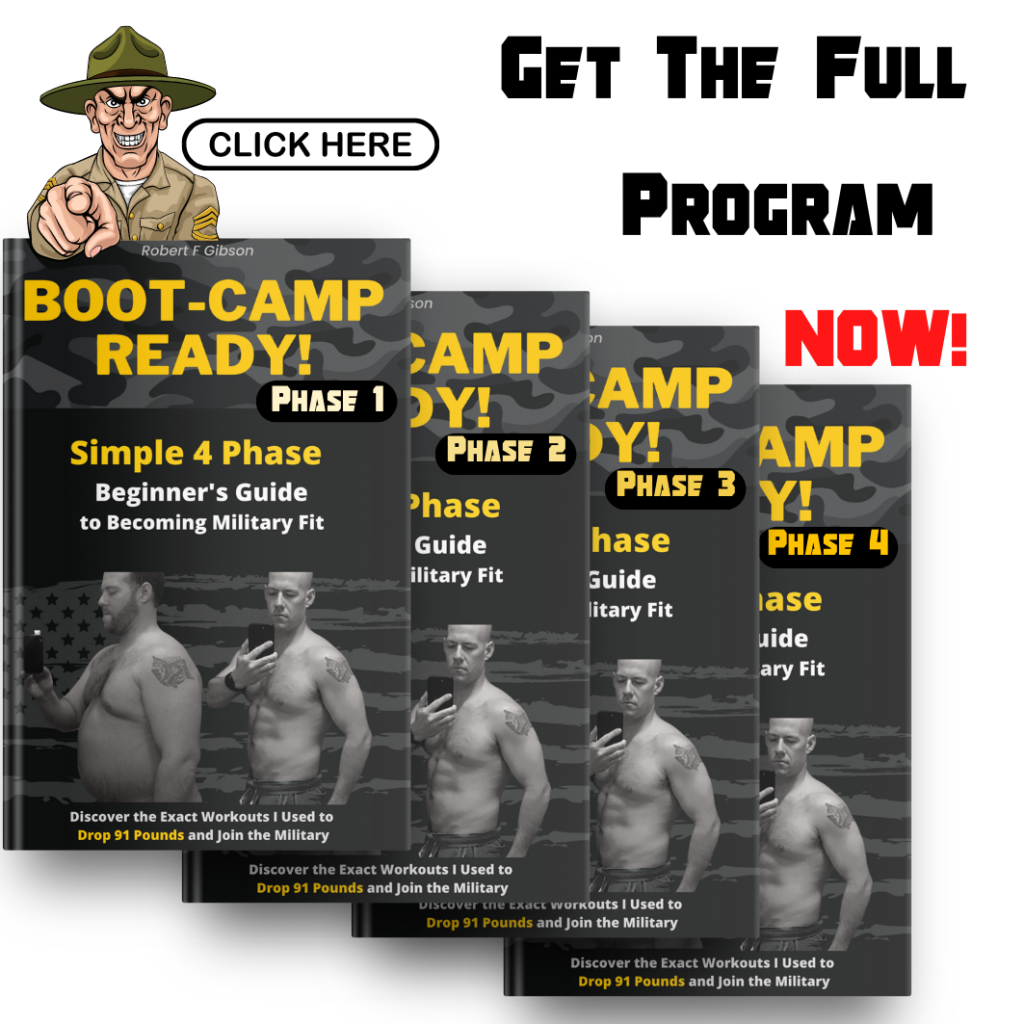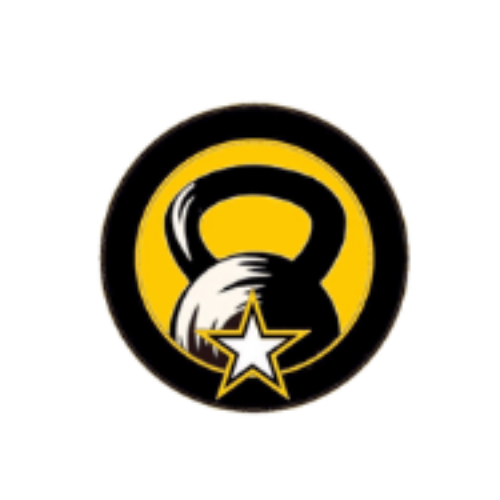Summary of Basic Training Workout #4: Upper Body
| Exercise | Reps | Sets | Rest | |
| 1 | Hand Release Push Up | 10 | 1 | 0 |
| 2 | Assisted Pull Ups | 5 | 1 | 2 Min |
| 3 | Lat Rips | 12 | 1 | 0 |
| 4 | OH Shoulder Press | 12 | 1 | 2 Min |
| 5 | OH Triceps Ext | 16 | 1 | 0 |
| 6 | 2 Arm Biceps Curls | 16 | 1 | – |
Description of Basic Training Workout #4: Upper Body
This upper body workout appears to be a well-rounded routine for beginners preparing for military fitness. Here’s how each exercise contributes to building overall upper body strength and endurance, which is essential for military training:
- Hand Release Push Up (10 reps, 1 set, 0 rest):
- Benefits: Targets the chest, shoulders, triceps, and core.
- Military Relevance: Mimics the movement of a standard push-up while emphasizing proper form, which is crucial for military physical fitness tests.
- Assisted Pull Ups (5 reps, 1 set, 2 minutes rest):
- Benefits: Strengthens the upper back, lats, and biceps.
- Military Relevance: Pull-ups are a common component of military fitness tests. The assisted variation allows beginners to build strength gradually.
- Lat Raises (12 reps, 1 set, 0 rest):
- Benefits: Targets the lateral deltoids, helping to improve shoulder stability and width.
- Military Relevance: Enhances shoulder strength and endurance, which is important for carrying gear and performing various military tasks.
- Overhead Shoulder Press (12 reps, 1 set, 2 minutes rest):
- Benefits: Focuses on the deltoids, trapezius, and triceps.
- Military Relevance: Improves the ability to push objects overhead, simulating actions like lifting and carrying heavy equipment.
- Overhead Triceps Extension (16 reps, 1 set, 0 rest):
- Benefits: Isolates the triceps for strength and tone.
- Military Relevance: Contributes to overall arm strength, which is essential for lifting and carrying gear.
- Two-Arm Biceps Curls (16 reps, 1 set, no specified rest):
- Benefits: Targets the biceps for arm strength.
- Military Relevance: Provides strength for lifting and carrying tasks, which are common in military training.
Overall considerations:
- Frequency: This workout can be performed 2-3 times a week for optimal results, allowing for at least one day of rest between sessions.
- Progression: As strength improves, gradually increase the number of sets, reps, or resistance to continue challenging the body.
- Rest: The specified rest intervals allow for recovery between exercises, promoting better performance and reducing the risk of injury.
This workout, when combined with cardiovascular training and lower body exercises, can contribute to a well-rounded fitness routine suitable for military preparation. Maintaining good form, staying consistent, and gradually increasing intensity to progress over time is crucial. Additionally, always consult with a fitness professional or healthcare provider before starting a new exercise program, especially if you have any pre-existing conditions or concerns.
Benefits of Basic Training Workout #4: Upper Body
Upper body muscular strength and muscular endurance are crucial components of physical fitness for individuals aiming to get into military shape. Here’s why these aspects are essential, especially for beginners:
- Functional Fitness:
- Military training often involves various physical activities, including carrying equipment, climbing, crawling, and lifting. Upper body strength is essential for performing these tasks efficiently and effectively.
- Load Carriage:
- Soldiers must carry heavy loads, including backpacks, weapons, and gear. Upper body strength is necessary for managing and supporting these loads, ensuring that individuals can move effectively while carrying equipment.
- Combat Readiness:
- In military scenarios, upper body strength is essential for combat readiness. The ability to push, pull, lift, and manipulate objects is crucial in combat.
- Obstacle Courses:
- Military training often involves obstacle courses requiring upper body strength and endurance—climbing walls, traversing ropes, and navigating challenging terrain demand a solid and enduring upper body.
- Muscular Endurance for Repetitive Tasks:
- Military duties may involve repetitive tasks, such as carrying stretchers, lifting and moving equipment, or performing sustained physical activities. Muscular endurance in the upper body helps individuals withstand the demands of these tasks over extended periods.
- Body Armor Wear:
- Wearing body armor is standard in military operations, and it adds significant weight to the upper body. Strong and enduring muscles are necessary to carry and maneuver effectively while wearing this additional load.
- Weapon Handling:
- Military personnel must be able to handle and control weapons effectively. Upper body strength is crucial for aiming, stabilizing firearms, and managing recoil during firing.
- Injury Prevention:
- Developing strength and endurance in the upper body helps prevent injuries, as it provides better support to the joints and reduces the risk of strains and overuse injuries during physical activities.
- Overall Physical Conditioning:
- A well-rounded fitness program includes both cardiovascular and muscular components. Building upper body strength and endurance contributes to overall physical conditioning, enhancing an individual’s ability to perform various physical tasks.
For beginners looking to get into military shape, it’s essential to focus on a balanced training program that includes upper-body strength exercises (such as push-ups, pull-ups, and bench presses) and endurance activities to prepare for the demands of military training and duties. It’s advisable to start gradually and progressively increase the intensity of workouts to avoid injuries and build a solid fitness foundation. Additionally, incorporating full-body exercises and functional movements into the training regimen can enhance overall physical preparedness.


